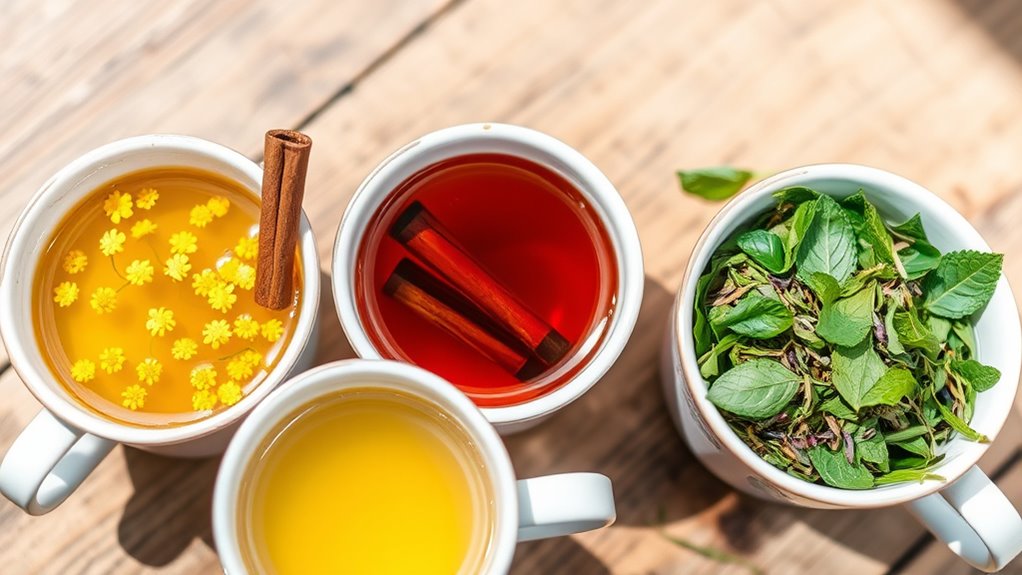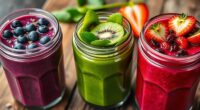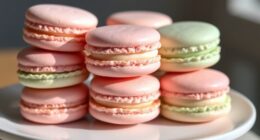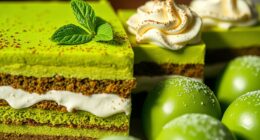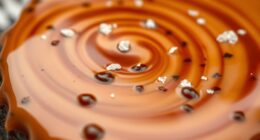Healing herbal teas like chamomile and rooibos have been used for centuries to support health, relaxation, and emotional well-being through traditional remedies. Chamomile helps calm nerves and promote restful sleep, while rooibos is rich in antioxidants and naturally caffeine-free, perfect for winding down. Blending herbs enhances their healing powers and suits your needs. If you want to explore more about these natural therapies and their benefits, continue exploring the secrets of herbal wellness.
Key Takeaways
- Chamomile and rooibos are traditional herbal teas valued for their calming and antioxidant properties, supporting overall health.
- These teas have been used in cultural healing practices for centuries, validated by modern science.
- Aromatic herbal blends enhance mood, relaxation, and mental clarity through sensory and therapeutic effects.
- Combining herbs like ginger or peppermint can boost healing benefits such as digestion and anti-inflammation.
- Drinking herbal teas promotes natural well-being, offering gentle, holistic support for immune health and emotional balance.
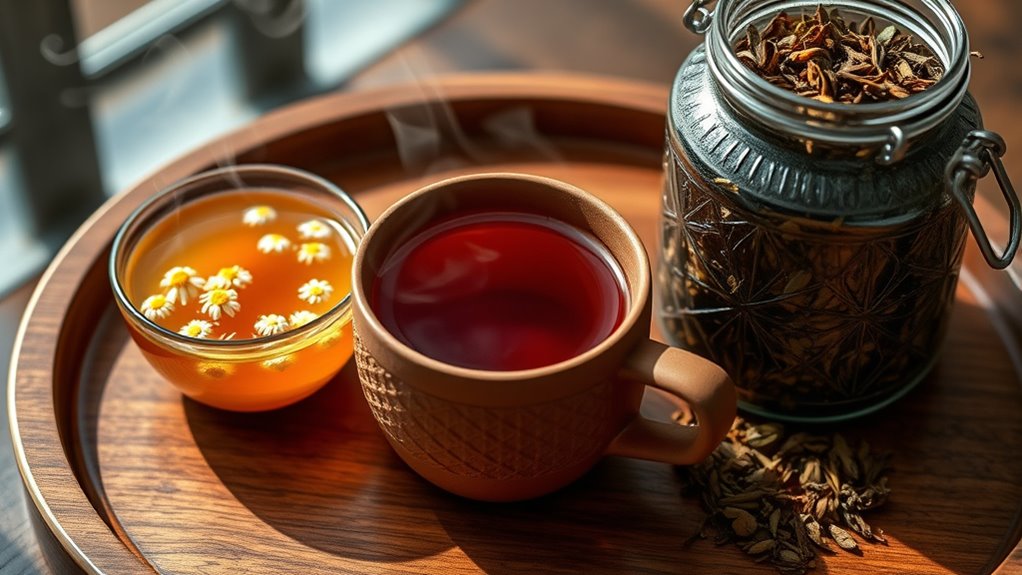
Herbal teas have been cherished for centuries as natural remedies that support health and well-being. When you sip on these calming infusions, you’re not just enjoying a warm beverage—you’re engaging in a tradition of holistic healing. One of the most compelling aspects of herbal teas is their ability to offer aromatherapy benefits that enhance your mood and relaxation. The fragrant aromas of chamomile, rooibos, or other herbal blends can lift your spirits or soothe your nerves, making each cup a sensory experience. These aromatic qualities are not accidental; they are part of the natural plant compounds that deliver therapeutic effects. When you choose herbal tea blends thoughtfully, you’re harnessing both flavor and healing power, creating a multi-sensory experience that promotes mental clarity and emotional balance.
Chamomile, for example, is renowned for its calming effects. Its gentle floral aroma helps ease anxiety and promotes restful sleep. Drinking chamomile tea before bed can lower stress levels and improve your overall sleep quality, which is essential for your physical and mental health. Rooibos, on the other hand, is a vibrant red herbal tea packed with antioxidants. Its naturally sweet, earthy flavor makes it a comforting choice, especially when you’re looking to boost your immune system or reduce inflammation. Plus, rooibos is caffeine-free, so it’s an excellent option for winding down at any time of day. The benefits of herbal tea blends extend beyond individual herbs: combining various botanicals can amplify their healing properties. For example, blending chamomile with peppermint might enhance digestion, while adding ginger can bring anti-inflammatory benefits. These carefully crafted herbal tea blends allow you to customize your health routine, whether you’re seeking relaxation, immune support, or digestive aid.
In addition, some herbal teas are specifically used in traditional remedies across different cultures, highlighting their historical significance and ongoing relevance in natural healing practices. As you explore the world of herbal teas, you’ll find that they serve as more than just beverages—they’re integral to traditional remedies passed down through generations. Many cultures have long relied on specific herbs for their medicinal properties, and modern science continues to validate these uses. Incorporating herbal teas into your daily life can be a simple yet powerful way to maintain balance and support your health naturally. Whether you turn to chamomile for its soothing qualities, rooibos for its antioxidants, or creative herbal tea blends tailored for your specific needs, you’re embracing a centuries-old practice that nurtures your body and mind. Each cup offers a moment of calm, a touch of nature’s healing, and a gentle reminder that sometimes, the simplest remedies are the most effective.
Frequently Asked Questions
Are Herbal Teas Safe for Children and Pregnant Women?
Herbal tea safety depends on the type and your child’s or pregnancy’s specific needs. You should always consult your healthcare provider before giving herbal teas to children or pregnant women, as some herbs may cause allergic reactions or interact with medications. While many herbal teas are generally safe in moderation, it is crucial to select those tailored for children’s health and pregnancy, ensuring you avoid potential risks and promote well-being.
Can Herbal Teas Replace Conventional Medical Treatments?
Herbal teas can’t replace conventional medicine, as their efficacy varies and they often lack the strength needed for serious health issues. While herbal teas offer soothing benefits and can complement treatments, they shouldn’t be relied upon solely. Always consult your healthcare provider before substituting herbal teas for medicine, since herbal teas vs. medicine differ markedly in their ability to treat conditions effectively. Use herbal teas as supportive remedies rather than primary treatments.
How Should Herbal Teas Be Stored for Maximum Freshness?
Like a trusty knight guarding a precious jewel, you should store herbal teas in airtight containers to preserve their freshness. Keep them in a cool, dark place away from sunlight, moisture, and strong odors. Proper storage techniques guarantee maximum freshness preservation, maintaining their flavor and potency. Avoid the pantry’s chaos and opt for a dedicated, sealed jar in your cupboard or pantry, so your herbal teas stay vibrant and effective over time.
Are There Any Known Allergies Associated With Herbal Teas?
You should be aware that herbal sensitivities and tea ingredient reactions are possible. Some people may experience allergies to specific herbs like chamomile or rooibos, leading to symptoms such as skin rashes, swelling, or breathing issues. Always check ingredient labels and start with small amounts to test for any reactions. If you notice unusual symptoms, stop drinking the tea and consult a healthcare professional.
What Is the Best Time of Day to Drink Herbal Teas?
Picture the day as a canvas, and your herbal tea as a splash of color. The best time of day for ideal consumption depends on your goals: sip chamomile in the evening to unwind, or enjoy green tea in the morning for a gentle boost. Typically, mid-morning or early evening works best, aligning with your body’s natural rhythms for maximum relaxation or alertness.
Conclusion
As you sip these healing herbal teas, remember they offer gentle relief and natural comfort. Unlike harsh medicines, they soothe your body and mind with simplicity. While pharmaceuticals can be powerful, these teas remind you that sometimes, healing comes from nature’s quietest gifts. Embrace their calming presence, and let their warmth be a reminder that true wellness often resides in the simplest, most unexpected places. In their gentle embrace, find your path to balance and renewal.
